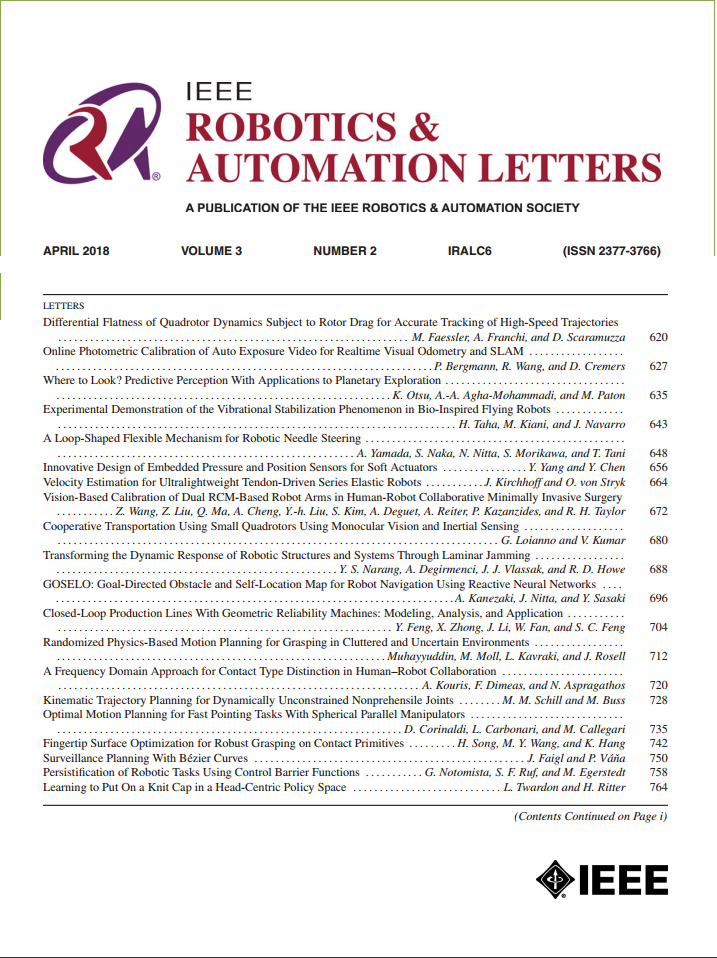利用图注意网络实现不确定拓扑环境中的多机器人可靠导航
IF 4.6
2区 计算机科学
Q2 ROBOTICS
引用次数: 0
摘要
本文研究不确定拓扑网络中的多机器人可靠导航问题,其目标是在路网不确定的情况下,使机器人团队的准时到达概率最大化。这些网络中的不确定性源于未知的边缘可遍历性,只有当机器人到达边缘的起始节点时才会知道。现有的方法往往难以适应实时的网络拓扑变化,使得它们不适合变化的拓扑环境。为了解决这一挑战,我们将该问题重新表述为部分可观察马尔可夫决策过程(POMDP)框架,并引入动态自适应图嵌入方法来捕捉导航任务的演变性质。我们通过将深度强化学习与图注意网络(GATs)集成,利用自注意来关注关键的图特征,进一步增强了每个机器人的策略学习过程。本文提出的基于图注意强化学习的多机器人自适应导航方法(MANGAR)采用广义策略梯度算法迭代优化机器人的实时决策过程。我们将MANGAR的性能与最先进的可靠导航算法以及一系列规范交通网络中的加拿大旅行者问题解决方案进行了比较,展示了在不确定拓扑网络中改进的适应性和性能。此外,两个机器人在具有不确定拓扑结构的自建室内环境中导航的现实世界实验证明了MANGAR的实用性。本文章由计算机程序翻译,如有差异,请以英文原文为准。
Multi-Robot Reliable Navigation in Uncertain Topological Environments With Graph Attention Networks
This letter studies the multi-robot reliable navigation problem in uncertain topological networks, which aims at maximizing the robot team's on-time arrival probabilities in the face of road network uncertainties. The uncertainty in these networks stems from the unknown edge traversability, which is only revealed to the robot upon its arrival at the edge's starting node. Existing approaches often struggle to adapt to real-time network topology changes, making them unsuitable for varying topological environments. To address the challenge, we reformulate the problem into a Partially Observable Markov Decision Process (POMDP) framework and introduce the Dynamic Adaptive Graph Embedding method to capture the evolving nature of the navigation task. We further enhance each robot's policy learning process by integrating deep reinforcement learning with Graph Attention Networks (GATs), leveraging self-attention to focus on critical graph features. The proposed approach, namely Multi-robot Adaptive Navigation via Graph Attention-based Reinforcement learning (MANGAR) employs the generalized policy gradient algorithm to optimize the robots' real-time decision-making process iteratively. We compare the performance of MANGAR with state-of-the-art reliable navigation algorithms as well as Canadian traveller problem solutions in a range of canonical transportation networks, demonstrating improved adaptability and performance in uncertain topological networks. Additionally, real-world experiments with two robots navigating within a self-constructed indoor environment with uncertain topological structures demonstrate MANGAR's practicality.
求助全文
通过发布文献求助,成功后即可免费获取论文全文。
去求助
来源期刊

IEEE Robotics and Automation Letters
Computer Science-Computer Science Applications
CiteScore
9.60
自引率
15.40%
发文量
1428
期刊介绍:
The scope of this journal is to publish peer-reviewed articles that provide a timely and concise account of innovative research ideas and application results, reporting significant theoretical findings and application case studies in areas of robotics and automation.
 求助内容:
求助内容: 应助结果提醒方式:
应助结果提醒方式:


